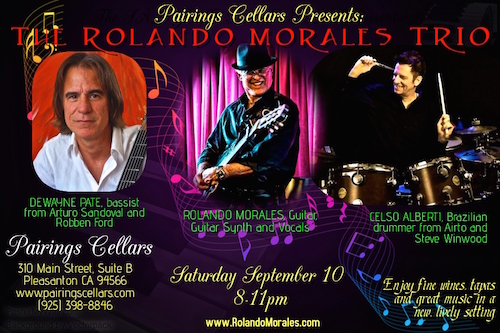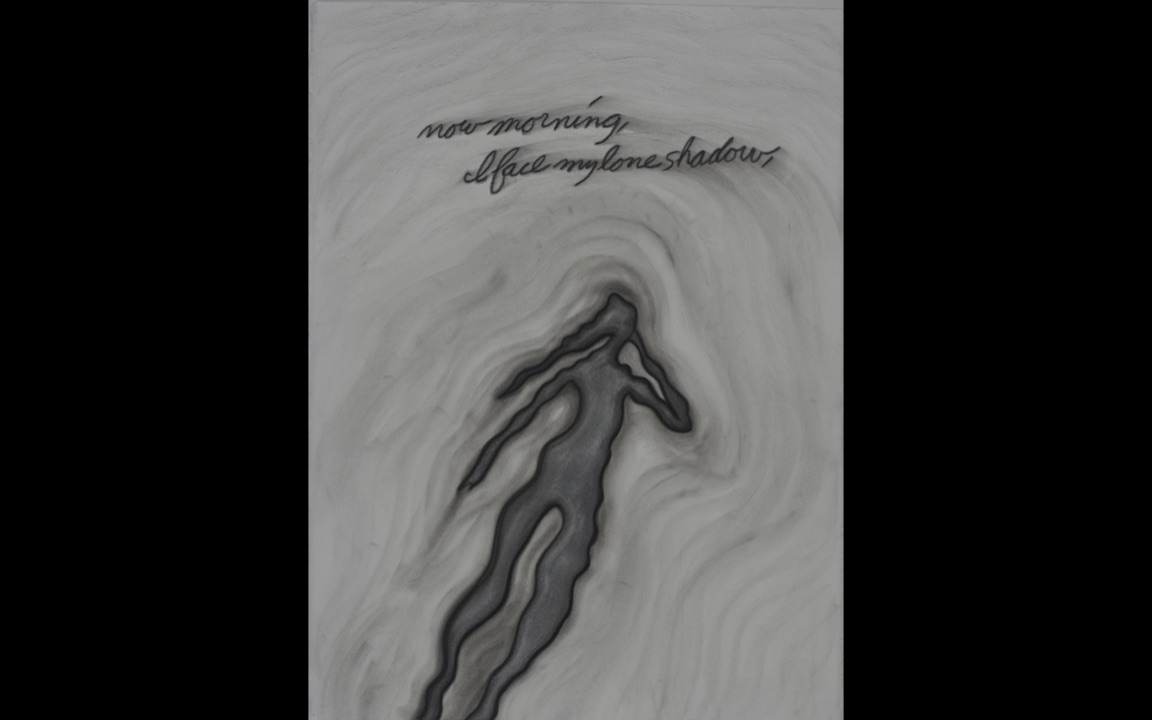
Hola, Mi Gente!
The year is flying by like a ghost. Are we already entering the last quarter? Did we really lose so many? Are these events really happening?
Throughout it all, I continue to perform my private and public shows throughout La Bahia and beyond, endeavoring to create good, positive feelings by sharing my music and passion. I feel grateful to still be doing so as frequently as I do.
September brings more of these blended opportunities, so please join me when you can! I’m looking forward to some great private wine country events and playing for a repeat client that should bring in around 1,500 people.
Publicly, I’m looking forward to Saturday Sept 10 from 8-11pm, when a new version of my Trio performs at Pairings Cellars, the brand new Pleasanton night spot. We’ll have the great Brazilian drummer Celso Alberti; the deeply grooving bassist Dewayne Pate; and I’ll lead the way on guitar, guitar synth and voice. Free! Details below.
For those of you keeping score, after months away, I’m also returning to Barone’s Restaurant on Saturday Sept 17,also in Pleasanton. Details below.
I’m also very happy to be contributing to the annual fund raiser put on by my beautiful friends at Sionfonds to benefit the children and their families in Haiti. These people really do exceptional work, have big hearts and start it all from right here in Oakland. The party happens on Sunday Sept 25 from 4-8pm at Venga Paella in Oakland. It’s a great night out with authentic paella dinners, sangria and other libations, Haitian crafts, and I’ll be providing the musical sound track. I urge you to click on their site to learn more and make your reservations. www.sionfonds.org. You can also reserve here: http://www.pingg.com/rsvp/pk8a76g22yq3zbkhp.
There’s much more happening in your new Calendar, so check it out and say “Hola!” See you at the show!
Ciao,
Rolando
LAST PUBLIC PERFORMANCE FOR SEPTEMBER 2016
Friday Sept 2, Don Pico’s Mexican Bistro, 461 El Camino Real, San Bruno, 6 to 9 pm. After almost a month away, Rolando returns to the place The Examiner and Independent have proclaimed has the “Best Seafood and Best Mexican Food” anywhere, on solo guitar and voice in the Restaurant Room. Call (650) 589-1163, www.donpicosbistro.com.
Sunday Sept 4, Maria, Maria Cantina, 1470 North Broadway, Walnut Creek, approx 2-5pm. Rolando returns for the Maria, Maria Tardeada series. Enjoy a Mexican brunch outdoors and Rolando performing on the newly renovated front patio on solo guitar and voice by the creek. He may be joined by flautist Bob Harrison. www.mariamariarestaurants.com, (925) 946-1010.
Saturday Sept 10, Pairings Cellars, 310 Main Street, Pleasanton CA 94566, 8-11pm. Rolando returns to this new, exciting social hotspot in downtown Pleasanton. This new wine bar features fine wines, tapas and the Rolando Morales Trio, this time featuring from Brazil, the superb drummer from Steve Winwood and Airto, the great Celso Alberti; bassist from Arturo Sandoval, Robben Ford and so many more, the great Dewayne Pate; and Rolando Morales leading the way on guitar, guitar synth and voice. Free! www.pairingscellars.com, (925) 398-8846.
Sunday Sept 11, Maria, Maria Cantina, 1470 North Broadway, Walnut Creek, approx 2-5pm. Enjoy a Mexican brunch and Rolando performing on the newly renovated front patio on solo guitar and voice by the creek. If it’s too hot, it will be indoors. He may be joined by Bob Harrison on flute. www.mariamariarestaurants.com, (925) 946-1010.
Tuesday Sept 13, Maria, Maria Cantina, 710 Camino Ramon Road, Danville CA, approx 6-9pm. Rolando returns to Carlos Santana’s most elegant restaurant for Taco Tuesday. $1 tacos, baby! And Rolando on solo guitar and voice with his diverse repertoire performing out on the patio by the fire pits. (925) 820-2366. See www.mariamariarestaurants.com.
Friday Sept 16, Don Pico’s Mexican Bistro, 461 El Camino Real, San Bruno, 6 to 9 pm. Celebrate 16 de Septiembre, Mexican Independence Day with Rolando as returns on solo guitar and voice in the intimate Restaurant Room. (650) 589-1163 and see www.donpicosbistro.com.
Saturday Sept 17, Barone’s Restaurant, 475 St. John St., Pleasanton CA, approx 7:30-10:30pm. Rolando returns to one of Pleasanton’s premier dining establishments. Enjoy exquisite meals, libations and Rolando’s vast repertoire in the Cocktail Lounge for a great night out. See www.baronespleasanton.com, (925) 426-0987.
Sunday Sept 18, Maria, Maria Cantina, 1470 North Broadway, Walnut Creek, approx 2-5pm. Enjoy a Mexican brunch at Carlos Santana’s lively cantina and Rolando performing on the newly renovated front patio on solo guitar and voice by the creek. He may be joined by Bob Harrison on flute. www.mariamariarestaurants.com, (925) 946-1010.
Friday Sept 23, Don Pico’s Mexican Bistro, 461 El Camino Real, San Bruno, 6-9 pm. Rolando returns on solo guitar and voice, now in the intimate Restaurant Room. Call (650) 589-1163 and www.donpicosbistro.com.
Sunday Sept 25, “Sionfonds for Haiti Presents: Party & Fund Raiser to Support Children & Their Families in Haiti,” Venga Paella, 229 Brush Street (at 3rd St.), Oakland 4 to 8pm. Rolando lends a hand to some dear friends in their mission to provide education, nutrition, job training, community improvements and health care to rural Haitian families. Enjoy a great party at this cool Oakland spot that will serve up a splendid paella dinner and drinks. Bring a friend and meet smart, fun, caring people while Rolando Morales provides live entertainment on solo guitar and voice. Bid for unique local and Haitian crafts and amazing services you’ll want, such as Haitian crafts, catered dinners with live music (by me!) and more! $45 includes dinner. www.sionfonds.org. Reserve here: http://www.pingg.com/rsvp/pk8a76g22yq3zbkhp
Tuesday Sept 27, Maria, Maria Cantina, 1470 North Broadway, Walnut Creek, approx. 6-9pm. Rolando returns to Carlos Santana’s Walnut Creek restaurant for Taco Tuesday. $1 tacos, baby! Enjoy Rolando on solo guitar and voice with his huge repertoire and big sound out on the front patio. See www.mariamariarestaurants.com, or call (925) 946-1010.
Friday Sept 30, Don Pico’s Mexican Bistro, 461 El Camino Real, San Bruno, 6-9 pm. Rolando returns on solo guitar and voice, now in the intimate Restaurant Room. Call (650) 589-1163 and www.donpicosbistro.com.


